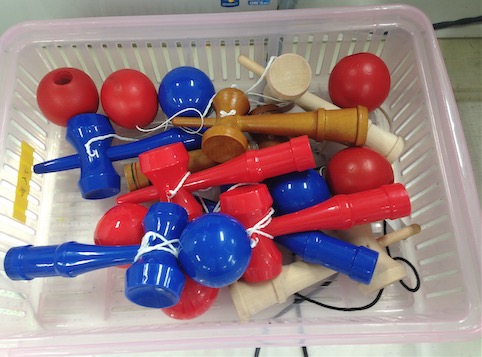From Feline Grace to Kendama Skill: The Hidden Physics of Impact Absorption
I’m Kuwako Ken, your Science Trainer. Every day is an experiment.
The Physics of a Cat’s Landing
Suddenly, have you ever witnessed a cat’s incredibly graceful movement? A cat jumping down from a height lands silently and beautifully, almost without a sound. Can you imagine that the secret to this fluid motion holds the ultimate key to mastering Kendama (the Japanese cup-and-ball game)? Today, I’m going to talk about the surprisingly familiar “Physics” that connects the seemingly unrelated acts of a “cat’s landing” and “Kendama”!First, take a look at this breathtaking footage:
Super Slow-Motion Footage of a Cat’s Landing When filmed with professional equipment, it becomes clear just how advanced a technique the cat is using. The moment before landing, the cat stretches its legs toward the ground. Then, from the instant its paws barely touch the surface, it deep-bends its joints like a suspension system, sinking low until its entire body is close to the ground.
This entire sequence of movements is the very secret to its perfect shock absorption. And imitating this “shock absorption technique” of the cat is the fastest way to master Kendama.
The Secret to Kendama Success
The truth is, I (a science teacher!) often play Kendama with my students when teaching “Parabolic Motion” (the movement of a ball thrown into the air) in my science classes.
Why Kendama?
You might wonder, but it’s because the process of getting better at Kendama requires mastering a crucial “body movement” that aligns perfectly with the laws of physics. Today, let’s explore the science hidden in Kendama together. Please try it with your children at home!
The Science Recipe
What You Need:
A Kendama (The first step is always the challenge!)
Method:
First, try playing Kendama without overthinking it. If you’re a beginner, you’ll find it difficult just to hold it correctly, the ball won’t obey, and it’ll be hard to land it on the cup. Try to aim for the “Big Cup” (Ozara), the largest one. …How did it go? You might already be feeling a bit frustrated with the elusive ball (lol). Well, let me share a “tip” with you.
The Key Technique for Kendama Mastery
Here’s how experts describe the secret to Kendama improvement: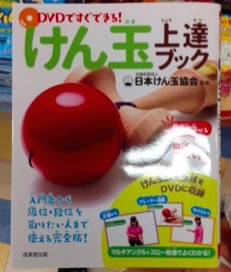
DVDで すぐできる!けん玉上達ブック (Kendama Mastering Book with DVD)
① Hold the big cup and bend your knees.② Toss the ball straight up.③ Insert the cup Just as the ball reaches its highest point, quickly move the cup directly underneath the ball.④ Catch the ball Bend your knees as the ball falls to receive it gently.
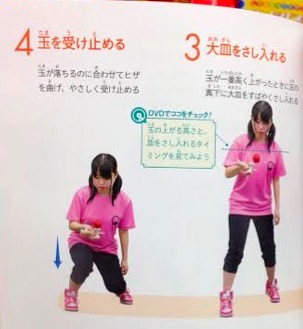
Quoted from: Kendama Mastering Book (Japan Kendama Association)
Try following these steps, focusing especially on ③ and ④. After a few attempts, you’ll notice a significant increase in your success rate compared to before. But why does this work?
The Science of Kendama
The most important thing in Kendama is “how to soften the impact” between the cup and the ball. The tips mentioned earlier help us achieve this. First, let’s look at ‘③ Insert the cup’:
Insert the cup “Just as the ball reaches its highest point.”
Why the highest point? Because at the peak of its throw (the highest point), the ball is transitioning from upward to downward motion, meaning its velocity is instantaneously “zero.”
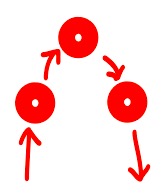
Since you are catching a ball that is stopped (zero velocity), the impact is minimized. This is a crucial concept taught in science and physics.Bending Your KneesHowever, in reality, it’s nearly impossible to insert the cup at the exact moment the velocity is “zero.” Inevitably, you end up catching the ball after it has started to fall (i.e., when it has a downward velocity). This is where the second tip comes in: ‘④ Catch the ball’ — “Bend your knees as the ball falls.” Doesn’t this bending motion look familiar? That’s right—it’s the exact same movement as the cat’s landing we saw at the beginning! The cat also deeply bends its legs like springs, increasing the time over which the force is applied to the ground, to cushion the impact (damage) from the collision. If you try to catch the ball with fixed knees and a fixed cup, it’s like two rigid objects colliding: a large force (impact) is applied instantaneously, and the ball bounces off with a loud “clack!”
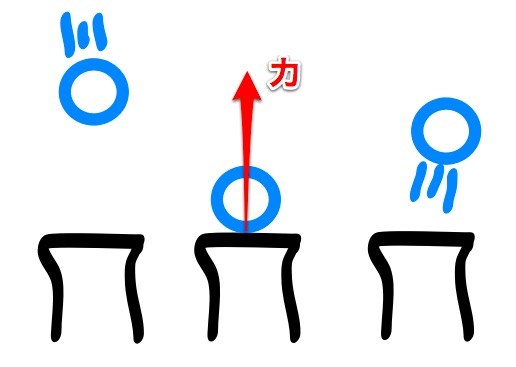
When the cup is held still: A large force is applied all at once (= Ouch!)
Therefore, at the moment the ball touches the cup, you use your knees to gently lower the cup. This allows you to gain more “time” during which the ball is in contact with the cup.

When the cup is lowered: The force is dispersed over time (= No Ouch!)
Since the force is dispersed over time (meaning the instantaneous force received is smaller), the ball doesn’t bounce and sticks perfectly to the cup, as if it were sucked in.
The Relationship between Momentum and ImpulseThis phenomenon of “increasing the time to decrease the force” can be neatly explained with a physics concept: “Momentum and Impulse.” It might be slightly complicated, but let’s take a look. The ball falls with a “Momentum $mv$” (the magnitude of its motion). The cup stops it (v’=0) by applying an “Impulse Ft” (Force times Time).
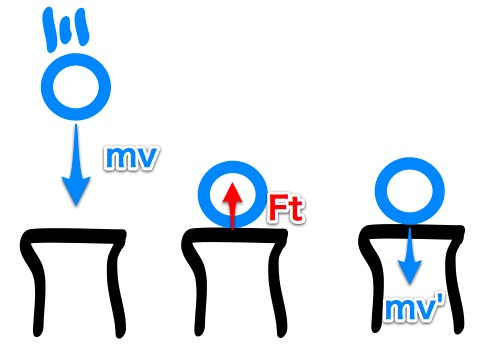
mv − Ft = mv’
(Initial Momentum $\quad$ + $\quad$ Impulse $\quad$ = $\quad$ Final Momentum)
Since the goal is to stop the ball, the final velocity $v’$ is 0, so:
$mv$ $\quad$ − $\quad$ $Ft$ = 0
Solving this equation for the force $F$ that the cup applies to the ball:
$F = \frac{mv}{t}$
(Force = Initial Momentum $\div$ Time)
This formula tells the whole story! To reduce the force $F$ received from the cup (which causes the bounce), you must either increase the “time $t$” in the denominator or decrease the “initial momentum $mv$ (or velocity $v$)” in the numerator. Therefore, the secrets to Kendama are…”Catching the ball at its highest point (where velocity $v$ is minimal)” $\rightarrow$ Strategy to minimize momentum.”Bending your knees to match the falling ball” $\rightarrow$ Strategy to increase time $t$….a perfect strategy based on two laws of physics!Relative Velocity** **By the way, bending your knees has one more benefit. By lowering your line of sight (the cup) along with the ball, the ball appears to fall slower from your perspective (this is called “reducing the relative velocity”). This is the same principle as watching a train moving slowly next to your moving train. This makes it easier to land the ball on the cup.
So Much to Learn from Kendama!
As you can see, the simple game of Kendama is packed with science, connecting a cat’s landing to physics equations. It truly is a perfect teaching tool. I encourage you to enjoy playing Kendama at home and experience the fun of physics firsthand: “I’m increasing the impact time now!” or “I’m doing what the cat does!” A simple game like this is how an interest in science often begins.: By the way, how you hold the Kendama cup is also important. Put your thumb over the top and press the bottom cup with your other fingers. This stabilizes the cup and increases your chances of success.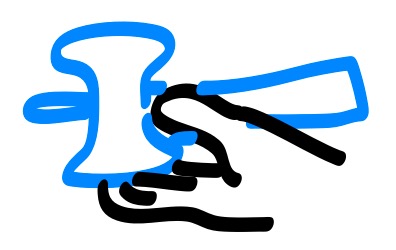
Inquiries and Requests
Bring the wonder and fun of science closer to you! We’ve compiled easy-to-understand fun science experiments you can do at home and their tips. Feel free to search through our articles!The content of our science blog has been turned into a book. Learn more hereFor information about the administrator, Kuwako Ken, click hereFor various requests (writing, lectures, experimental classes, TV supervision/appearances, etc.), click here– Article updates are posted on X!
![]() We post experimental videos on the Science Channel!
We post experimental videos on the Science Channel!

